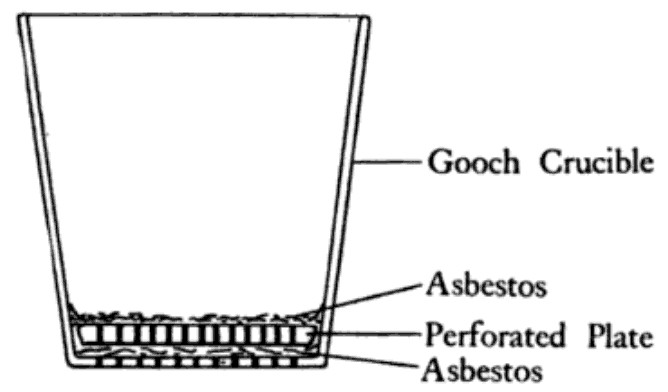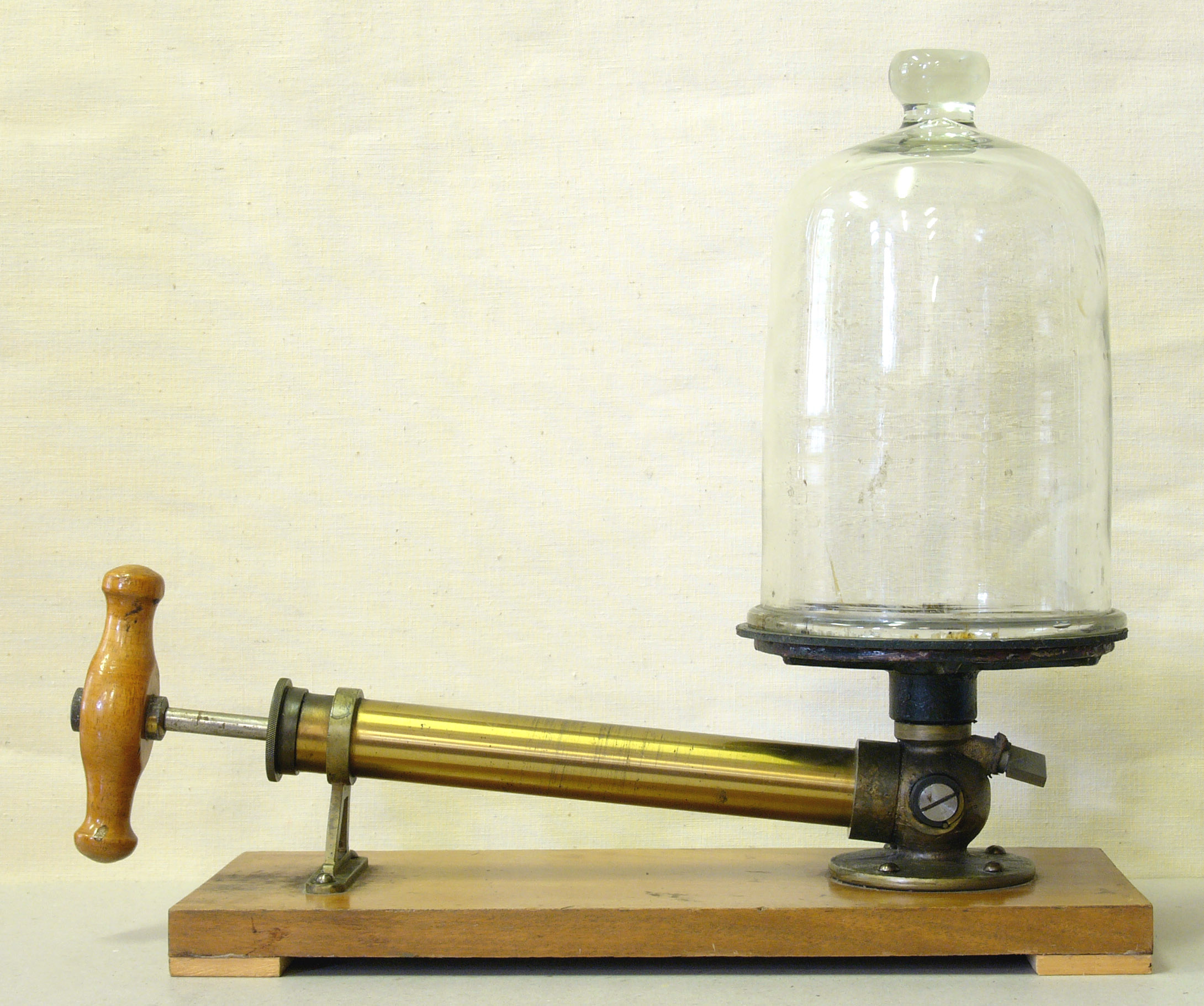|
Büchner Funnel
A Büchner funnel is a piece of laboratory equipment used in filtration. It is traditionally made of porcelain, but glass and plastic funnels are also available. On top of the funnel-shaped part there is a cylinder with a fritted glass disc/perforated plate separating it from the funnel. The Hirsch funnel has a similar design; it is used similarly, but for smaller quantities of material. The main difference is that the plate of a Hirsch funnel is much smaller, and the walls of the funnel angle outward instead of being vertical. A funnel with a fritted glass disc can be used immediately. For a funnel with a perforated plate, filtration material in the form of filter paper is placed on the plate, and the filter paper is moistened with a liquid to prevent initial leakage. The liquid to be filtered is poured into the cylinder and drawn through the perforated plate/fritted glass disc by vacuum suction. The main advantage in using this type of filtration is that it proceeds much more ... [...More Info...] [...Related Items...] OR: [Wikipedia] [Google] [Baidu] |
Vacuum Pump
A vacuum pump is a type of pump device that draws gas particles from a sealed volume in order to leave behind a partial vacuum. The first vacuum pump was invented in 1650 by Otto von Guericke, and was preceded by the suction pump, which dates to antiquity. History Early pumps The predecessor to the vacuum pump was the suction pump. Dual-action suction pumps were found in the city of Pompeii. Arabic engineer Al-Jazari later described dual-action suction pumps as part of water-raising machines in the 13th century. He also said that a suction pump was used in siphons to discharge Greek fire. The suction pump later appeared in medieval Europe from the 15th century. Donald Routledge Hill (1996), ''A History of Engineering in Classical and Medieval Times'', Routledge, pp. 143 & 150-2 Donald Routledge Hill, "Mechanical Engineering in the Medieval Near East", ''Scientific American'', May 1991, pp. 64-69 (cf. Donald Routledge HillMechanical Engineering By the 17th century, water ... [...More Info...] [...Related Items...] OR: [Wikipedia] [Google] [Baidu] |
Filter Paper
Filter paper is a semi-permeable paper barrier placed perpendicular to a liquid or air flow. It is used to separate fine solid particles from liquids or gases. The raw materials are typically different pulp (paper), paper pulps. The pulp may be made from softwood, hardwood, fiber crops, or mineral fibers. Properties Filter paper has various properties. The important parameters are wet strength, porosity, particle Retention rate, retention, volumetric flow rate, compatibility, efficiency and capacity. There are two mechanisms of filtration with paper; volume, and surface. By volume filtration, the particles are caught in the bulk of the filter paper. By surface filtration, the particles are caught on the paper surface. Filter paper is mostly used because of the ability of a small piece of filter paper to absorb a significant volume of liquid. Manufacture The raw materials are different pulp (paper), paper pulps. The pulp may be from softwood, hardwood, fiber crops, mineral fibr ... [...More Info...] [...Related Items...] OR: [Wikipedia] [Google] [Baidu] |
Royal Society Of Chemistry
The Royal Society of Chemistry (RSC) is a learned society and professional association in the United Kingdom with the goal of "advancing the chemistry, chemical sciences". It was formed in 1980 from the amalgamation of the Chemical Society, the Royal Institute of Chemistry, the Faraday Society, and the Society for Analytical Chemistry with a new Royal Charter and the dual role of learned society and professional body. At its inception, the Society had a combined membership of 49,000 in the world. The headquarters of the Society are at Burlington House, Piccadilly, London. It also has offices in Thomas Graham House in Cambridge (named after Thomas Graham (chemist), Thomas Graham, the first president of the Chemical Society) where ''RSC Publishing'' is based. The Society has offices in the United States, on the campuses of The University of Pennsylvania and Drexel University, at the University City Science Center in Philadelphia, Pennsylvania, in both Beijing and Shanghai, People' ... [...More Info...] [...Related Items...] OR: [Wikipedia] [Google] [Baidu] |
Büchner Funnel - With Jointed Cone
Büchner (or Buechner) is a German language surname related to the word ''Buche'' () and may refer to: * Eberhard Büchner (born 1939), German tenor * Ernst Büchner (1850–1925), German chemist after whom the Büchner flask and Büchner funnel are named * Franz Büchner (1898-1920), German First World War flying ace * Georg Büchner (1813–1837), German writer and playwright * Joachim Büchner (1905–1978), German athlete * Ludwig Büchner (1824–1899), German philosopher * Wolfgang Büchner (canoeist), German slalom canoeist * Wolfgang Büchner (journalist) (born 1966), German journalist In the anglicized spelling "Buechner", it may refer to: *Frederick Buechner (1926-2022), American author and minister * Jack Buechner (1940-2020), American lawyer and politician * John C. Buechner (1934–2018), American educator and politician * Karl Buechner (born 1971), American metalcore vocalist * Margaret Buechner (1922–1998), a German-born, American composer * Sara Davis Buechner ... [...More Info...] [...Related Items...] OR: [Wikipedia] [Google] [Baidu] |
Eduard Buchner
Eduard Buchner (; 20 May 1860 – 13 August 1917) was a German chemist and Zymurgy, zymologist, awarded the 1907 Nobel Prize in Chemistry for his work on fermentation (biochemistry), fermentation. Biography Early years Buchner was born in Munich to a physician and Doctor Extraordinary of Forensic Medicine. His older brother was the bacteriologist Hans Ernst August Buchner. In 1884, he began studies of chemistry with Adolf von Baeyer and of botany with Carl Nägeli, at the Botanic Institute in Munich. After a period working with Otto Fischer (cousin of Emil Fischer) at the University of Erlangen–Nuremberg, University of Erlangen, Buchner was awarded a doctorate from the Ludwig Maximilian University of Munich, University of Munich in 1888 under Theodor Curtius. Academics Buchner was appointed assistant lecturer in the organic laboratory of Adolf von Baeyer in 1889 at the University of Munich. In 1891, he was promoted to lecturer at the same university. In the autumn of 1893, ... [...More Info...] [...Related Items...] OR: [Wikipedia] [Google] [Baidu] |
Gooch Crucible
{{Short description, Filtration device A Gooch crucible, named after Frank Austin Gooch,Classic Kit: Gooch's Cruciblby Dr. Andrea Sella is a filtration device for laboratory use (and was also called a Gooch filterJ. Am. Chem. Soc., 1882, 4 (8), p 161). It is convenient for collecting a precipitate directly within the vessel in which it is to be dried, possibly Ash (analytical chemistry), ashed, and finally weighed in gravimetric analysis. The device was originally a standard platinum laboratory crucible with a perforated base into which asbestos pulp was placed to form the filter mat. The crucible was then heated in an oven to dry out until it attained constant weight. The use of these materials meant that after filtration, the crucible and its contents could be subjected to high temperature to dry the filtrate and possibly oxidize or ash it to minimum weight. However, because of the high cost of platinum, versions made of porcelain were introduced in 1882. [...More Info...] [...Related Items...] OR: [Wikipedia] [Google] [Baidu] |
Buchner Ring
Buchner is a German surname. Notable people with this surname include the following: * Andreas Buchner (1776–1854), German historian * Annemarie Buchner (1924-2014), German Olympian * August Buchner (1591–1661), German influential Baroque poet * Eduard Buchner (1860–1917), German chemist and zymologist * Edward Franklin Buchner (1868–1929), American psychologist * Ernst Buchner (curator) (1892–1962), German museum administrator * Hans Buchner (1483–1538, German organist and composer * Hans Ernst August Buchner (1850–1902), German bacteriologist * Johann Andreas Buchner (1783–1852), German pharmacologist * Ludwig Andreas Buchner (1813–1897), German pharmacologist * Paul Buchner Paul Buchner (June 1531 – 13 November 1607) was a German architect, geometer, carpenter and screw maker from Nuremberg. Life Buchner grew up in Nuremberg and was an apprentice carpenter and screw maker, training under his cousin, Leonhard ... (1531–1607), German architect, geo ... [...More Info...] [...Related Items...] OR: [Wikipedia] [Google] [Baidu] |
Büchner Flask
A Büchner flask, also known as a vacuum flask,The use of the term ''vacuum flask'' sometimes causes confusion with the thermos flask filter flask, suction flask, side-arm flask, or Bunsen flask, is a thick-walled Erlenmeyer flask with a short glass tube and hose barb protruding about 1-2 cm from its neck. Description The short tube and hose barb effectively act as an adapter over which the end of a thick-walled hose can be fitted to form a connection to the flask. The other end of the hose can be connected to source of vacuum such as an aspirator, vacuum pump, or house vacuum. Preferably this is done through a trap (see below), which is designed to prevent the water to be sucked back from the aspirator into the Büchner flask. The purpose of applying a vacuum is to speed the filtration by providing a pressure differential across the filter medium that is greater than that produced by gravity alone. Operation The thick wall of the Büchner flask provides it the strength to withs ... [...More Info...] [...Related Items...] OR: [Wikipedia] [Google] [Baidu] |
Vacuum
A vacuum (: vacuums or vacua) is space devoid of matter. The word is derived from the Latin adjective (neuter ) meaning "vacant" or "void". An approximation to such vacuum is a region with a gaseous pressure much less than atmospheric pressure. Physicists often discuss ideal test results that would occur in a ''perfect'' vacuum, which they sometimes simply call "vacuum" or free space, and use the term partial vacuum to refer to an actual imperfect vacuum as one might have in a laboratory or in space. In engineering and applied physics on the other hand, vacuum refers to any space in which the pressure is considerably lower than atmospheric pressure. The Latin term ''in vacuo'' is used to describe an object that is surrounded by a vacuum. The ''quality'' of a partial vacuum refers to how closely it approaches a perfect vacuum. Other things equal, lower gas pressure means higher-quality vacuum. For example, a typical vacuum cleaner produces enough suction to reduce air pressur ... [...More Info...] [...Related Items...] OR: [Wikipedia] [Google] [Baidu] |
Liquid
Liquid is a state of matter with a definite volume but no fixed shape. Liquids adapt to the shape of their container and are nearly incompressible, maintaining their volume even under pressure. The density of a liquid is usually close to that of a solid, and much higher than that of a gas. Therefore, liquid and solid are classified as condensed matter. Meanwhile, since both liquids and gases can flow, they are categorized as fluids. A liquid is composed of atoms or molecules held together by intermolecular bonds of intermediate strength. These forces allow the particles to move around one another while remaining closely packed. In contrast, solids have particles that are tightly bound by strong intermolecular forces, limiting their movement to small vibrations in fixed positions. Gases, on the other hand, consist of widely spaced, freely moving particles with only weak intermolecular forces. As temperature increases, the molecules in a liquid vibrate more intensely, causi ... [...More Info...] [...Related Items...] OR: [Wikipedia] [Google] [Baidu] |






